
Kirchhoff's and Ohm's laws are used to solve DC circuits problems. There are 3 examples; solve them in the order that they are presented; this will make it easier to fully understand them.
Problem 1
Find current \( i \), voltages \( V_{R_1} \) and \( V_{R_2} \) in the ciruit below given that the voltage source \( e = 20 \) Volts, the resistances \( R_1 = 100 \; \Omega \) and \( R_2 = 300 \; \Omega \).

Apply Kirchhoff's law of voltage to the closed loop in the circle and write the equation \[ e - V_{R_1} - V_{R_2} = 0 \quad (1) \] Use Ohm's law to write \[ V_{R_1} = i R_1 \; \text{and} \; V_{R_2} = i R_2 \] Substitute \( V_{R_1} \) and \( V_{R_2} \) by their expression in equation (1) \[ e - i R_1 - i R_2 = 0 \] Rearrange the above so that all term containing \( i \) are on one side \[ i R_1 + i R_2 = e \] Factor \( i \) out \[ i ( R_1 + R_2) = e \] Solve for \( i \) \[ i = \dfrac{e}{R_1 + R_2} \] Substitute known quantities \[ i = \dfrac{20}{100 + 300} = 0.05 \; \text{A} \] Calculate \( V_{R_1} \) and \( V_{R_2} \) using Ohm's law \[ V_{R_1} = i R_1 = 0.05 \times 100 = 5 \; \text{V} \] \[ V_{R_2} = i R_2 = 0.05 \times 300 = 15 \; \text{V} \]
Problem 2
Given the voltage sources \( e_1 = 20 \) V, \( e_2 = 5 \) V, and the resistances \( R_1 = 100 \; \Omega \) , \( R_2 = 300 \; \Omega \) and \( R_3 = 50 \; \Omega \), find all currents through and voltages across the resistors in the circuit.

Kirchhoff's Law of voltage for all three loops \( L_1 \) , \( L_2 \) and \( L_3 \) gives \[ \text{Loop} \; L_1 \; : e_1 - V_{R_1} - V_{R_2} = 0 \quad (1) \] \[ \text{Loop} \; L_2 \; : V_{R_2} + e_2 - V_{R_3 } = 0 \quad (2) \] \[ \text{Loop} \; L_3 \; : e_1 - V_{R_1} + e_2 - V_{R_3 } = 0 \quad (3) \]
Note that if we add equations (1) and (2), we obtain equation (3). Hence any 2 equations from the 3 can be used to solve the given problems. The third one does not give any extra information.
We have 3 unknowns, we therefore need another equation independent from the above equation.
Kirchhoff's Law of current applied at node A gives \[ i_1 = i_2 + i_3 \quad (4) \] So we select equations (1), (2) and (4) to write the system of equations \[ e_1 - V_{R_1} - V_{R_2} = 0 \quad (5) \] \[ V_{R_2} + e_2 - V_{R_3 } = 0 \quad (6) \] \[ i_1 = i_2 + i_3 \quad (7) \] Use Ohm's law to rewrite \( V_{R_1} \) and \( V_{R_2} \) as follows \[ V_{R_1} = R_1 i_1 \; \text{and} \; V_{R_2} = R_2 i_2 \] Substitute the above in equations (5) and (6) and rewrite the system of equations (5), (6) and (7) as \[ R_1 i_1 + R_2 i_2 = e_1 \quad (8) \] \[ R_2 i_2 - R_3 i_3 = - e_2 \quad (9) \] \[ i_1 = i_2 + i_3 \quad (10) \] Substitute the known quantities by their numerical values to obtain a linear system system of equations with three unknowns \( i_1 \), \( i_2\) and \( i_3 \) . \[ 100 i_1 + 300 i_2 = 20 \quad (11) \] \[ 300 i_2 - 50 i_3 = - 5 \quad (12) \] \[ i_1 = i_2 + i_3 \quad (13) \] There are many ways to solve the above system. One way is to substitute \( i_1 \) by \( i_2 + i_3 \) in equations (11) and (12) to obtain a system with two unknowns \[ 100 (i_2 + i_3) + 300 i_2 = 20 \quad (14) \] \[ [300 i_2 - 50 i_3 = - 5 \quad (15) \] Rearrange to rewrite the above system as \[ 400 i_2 + 100 i_3 = 20 \quad (16) \] \[ 300 i_2 - 50 i_3 = - 5 \quad (17) \] Multiply all terms of equation (17) above by 2 and rewrite the above system as \[ 400 i_2 + 100 i_3 = 20 \quad (18) \] \[ 600 i_2 - 100 i_3 = - 10 \quad (19) \] Add side by side equations (18) and (19) to obtain one equation in one variable \[ 1000 i_2 = 10 \] Solve for \( i_2 \) \[ i_2 = 10/1000 = 0.01 \quad \text{A} \] Substitute \( i_2 \) by \( 0.01 \) in equation (16) and solve for \( i_3 \) \[ 400 \times 0.01 + 100 i_3 = 20 \] Solve for \( i_3 \) \[ i_3 = 0.16 \quad \text{A} \] Use equation (13) to solve for \(i_1\) \[ i_1 = i_2 + i_3 = 0.01 + 0.16 = 0.17 \quad \text{A} \] We now calculate the voltages across the resistors \[ V_{R_1} = R_1 I_1 = 100 \times 0.17 = 17 \quad \text{V} \] \[ V_{R_2 } = R_2 I_2 = 300 \times 0.01 = 3 \quad \text{V} \] \[ V_{R_3 } = R_3 I_3 = 50 \times 0.16 = 8 \quad \text{V} \]
Problem 3
Find all currents through and voltages across the resistors in the circuit below, given the voltage sources \( e_1 = 20 \) V, \( e_2 = 5 \) V, and the resistances \( R_1 = 100 \; \Omega \) , \( R_2 = 120 \; \Omega \), \( R_3 = 60 \; \Omega \), \( R_4 = 40 \; \Omega \), \( R_5 = 240\; \Omega \) and \( R_6 = 80 \; \Omega \).
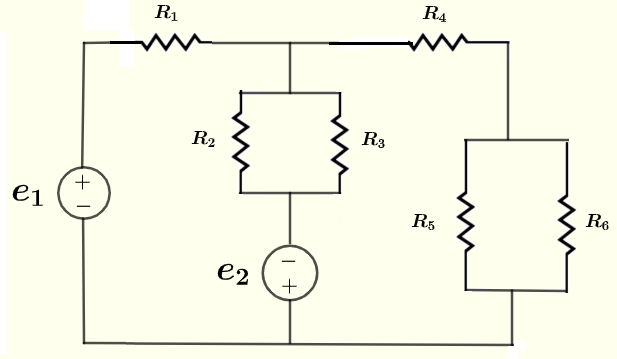
All the details of the solution are presented and in order to make this presentation clear and easy to understand, the solution of this example has 5 parts.
Part 1: Simplify the circuit by grouping resistors
If we apply Kirchhoff's law to the closed loops and nodes in the given circuit above, we will end up with a large number of equations to solve.
However, a quick analysis of the given circuit shows that some of the resistors are parallel and series configurations as shown below.
Resistors \( R_2 \) and \( R_3 \) are in parallel and their equivalent resistance is \( R'_2 \) as shown in the circuit below.
\( R_5\) and \( R_6 \) are in parallel and their equivalent resistance is in series with \( R_4 \) and their overall equivalent resistance is \( R'_3 \) as shown in the circuit below.
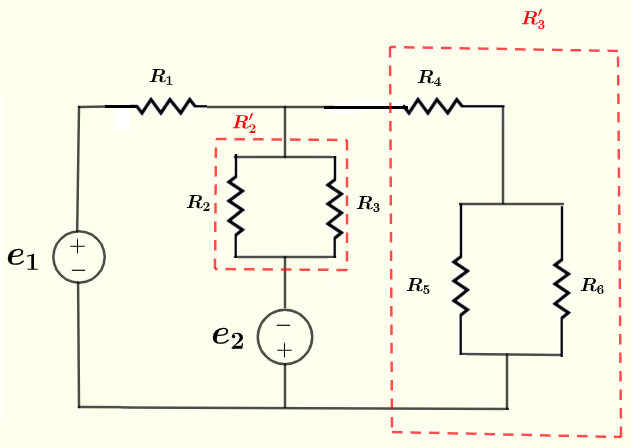
Use the formula for resistors in parallel to write
\[ \dfrac{1}{R'_2} = \dfrac{1}{R_2} + \dfrac{1}{R_3} \]
Solve the above for \( R'_2 \) to obtain
\[ R'_2 = \dfrac{R_2 \cdot R_3}{R_2 + R_3} \]
Substitute the knwon quantities to obtain
\[ R'_2 = \dfrac{120 \cdot 60}{120 + 60} = 40 \; \Omega \]
Use formula for resistors in parallel to \( R_5\) and \( R_6 \) and add it to \( R_4 \) to write \( R'_3 \) as
\[ R'_3 = R_4 + \dfrac{R_5 \cdot R_6}{R_5 + R_6} \]
Substitute the knwon quantities to obtain
\[ R'_3 = 40 + \dfrac{240 \cdot 80}{240 + 80} = 100 \]
Part 2: Calculate \( i_1 \), \( i_2 \) and \( i_3 \) using Kirchhoff's law
We now have a much simpler circuit to solve as shown below.
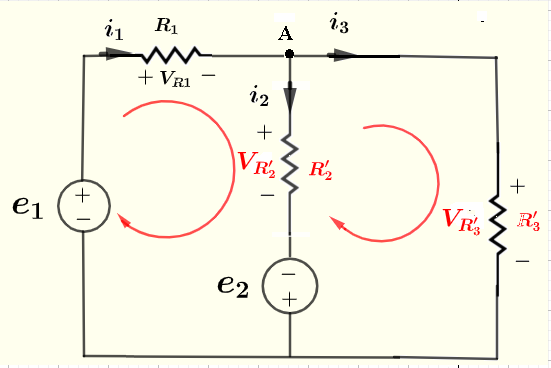
There are 3 unkwons \( i_1 \), \( i_2 \) and \( i_3 \) and we therefore need 3 equations.
Use Kirchhoff's law of current at node A to write
\[ i_1 = i_2 + i_3 \quad (1) \]
Use Use Kirchhoff's law of voltage for the loop on the left
\[ e_1 - V_{R_1} - V_{R'_2} + e_2 = 0 \quad (2) \]
Use Use Kirchhoff's law of voltage for the loop on the right
\[ - e_2 + V_{R'_2} - V_{R'_3} = 0 \quad (3) \]
Use Ohm's law to write
\[ V_{R_1} = R_1 i_1 \]
\[ V_{R'_2} = R'_2 i_2 \]
\[ V_{R'_3} = R'_3 i_3 \]
Substitute the above voltages in equations (2) and (3) and include equation (1) to rewrite the system of 3 equations with 3 unknowns
\[ e_1 - R_1 i_1 - R'_2 i_2 + e_2 = 0 \]
\[ - e_2 + R'_2 i_2 - R'_3 i_3 = 0 \]
\[ i_1 = i_2 + i_3 \]
Substitute the knwon quantities, simplify and rewrite the above system in the form.
\[ 100 i_1 + 40 i_2 = 25 \quad (4) \]
\[ 40 i_2 - 100 i_3 = 5 \quad (5) \]
\[ i_1 = i_2 + i_3 \quad (6) \]
There are many ways to solve systems of linear equations. Let us use the method of substitution.
Substitute \( i_1 \) by \( i_2 + i_3 \) in equations (4) and rewrite equations (4) and (5) as follows
\[ 100 (i_2 + i_3) + 40 i_2 = 25 \quad (7) \]
\[ 40 i_2 - 100 i_3 = 5 \quad (8) \]
Simplify and group
\[ 140 i_2 + 100 i_3 = 25 \]
\[ 40 i_2 - 100 i_3 = 5 \]
Add the above equations to eliminate \( i_3 \)
\[ 180 i_2 = 30 \]
Solve for \( i_2 \]
\[ i_2 = 30/180 = 1/6 \; \text{A} \]
Use equation (7) (or (8) ) to find \( i_3 \)
\[ 100 i_3 = 25 - 140 i_2 \]
\[ i_3 = 1/60 \; \text{A} \]
Use equation (6) to find \( i_1 \)
\[ i_1 = i_2 + i_3 = 1/6 + 1/60 = 11/60 \; \text{A} \]
Part 3: Calculate currents in resistors \( R_2 \) and \( R_3 \)
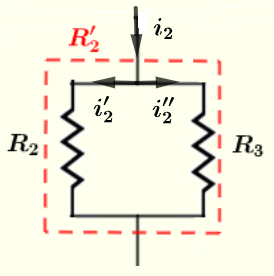
Apply Kirchhoff's law of current \[ i_2'+i_2'' = i_2 = 1/6 \] Kirchhoff's law of voltage to the closed loop. \[ R_2 i_2' - R_3 i_2'' = 0 \] Substitute known quantities in the above equation \[ 120 i_2' - 60 i_2'' = 0 \] Solve the system of 2 equations 2 unknowns \[ i_2'+i_2'' = 1/6 \] \[ 120 i_2' - 60 i_2'' = 0 \] to obtain \[ i_2' = 1/18 \; \text{A} \quad \text{and} \quad i_2'' = 1/9 \; \text{A} \]
Part 4: Calculate currents in resistors \( R_5 \) and \( R_6 \)
We now calculate the currents through resistors \( R_5 \) and \( R_6 \) using the circuit below
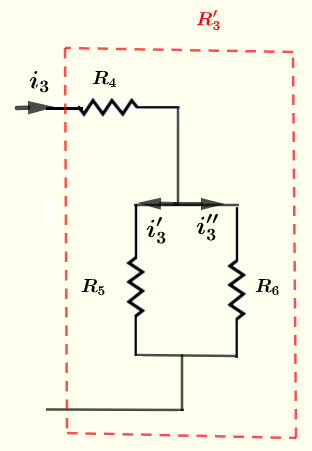
Apply Kirchhoff's law of current \[ i_3'+i_3'' = i_3 = 1/60 \] Kirchhoff's law of voltage to the closed loop. \[ R_5 i_3' - R_6 i_3'' = 0 \] Substitute known quantities in the above equation \[ 240 i_2' - 80 i_2'' = 0 \] Solve the system of 2 equations 2 unknowns \[ i_3'+i_3'' = 1/60 \] \[ 240 i_2' - 80 i_2'' = 0 \] to obtain \[ i_3' = 1/240 \; \text{A} \quad \text{and} \quad i_3''' = 1/80 \; \text{A} \]
Part 5: Calculate voltages in all resistors We now list all resistors and the currecnts through each one of them; and then calculate the voltages across each one of them.